|
|
By Eva, on September 7th, 2011
Marlie caught the bus to school today; her first day in a classroom in more than a year and a half. I think I was more misty than when she first left for kindergarten. This summer, since arriving home, has been far more of a roller coaster ride than we’d expected.
There were the immediate needs of making our house livable. Our brittanys, Sadie and Ayla, missed us quite a lot. In our absence, they spent their time renovating the siding on our garage and garden shed with their teeth. I suspect some sort of small, striped rodent had taken refuge under one of the boards, and the dogs felt any force was reasonable to dislodge it. On the other end of the house, the wall above our bed in the master bedroom had become home to several families of birds, who pecked ingress holes in the aging planks, and tossed out the insulation to make room for their families.
A rather unpleasant smelling puddle below our house turned out to be an overflowing septic tank. While the man from Roto Rooter had the lid off and was working on pumping it, I thought it would be educational for the girls to see inside a septic tank: a morbidly interesting experience. A thick layer had formed on the top of the sh*# in the tank, which Mr. Roto Rooter had to break up with a big paddle, sort of like stirring a pot of chili with a large wooden spoon. Except, surfacing over and over in the ooze were the unmistakable shape of things I’d not really wanted to point out to my tween and teen daughters. Our septic tank was full of floating, used condoms. Apparently our renters had been busy and did not realize that condoms, unlike toilet paper and poop, do not break down in a septic system. A week later, Roto Rooter made a return trip when the tank again began overflowing. The outflow was plugged. Probably with many months worth of latex.
We’ve been purging, even still. Suddenly being surrounded by so much stuff felt like landing in the middle of an episode of Hoarders. We’d developed an aversion to our own belongings; they felt suffocating. While we know we’ll never pare back down to one suitcase or backpack per person while living in one place, we now fully understand how possessions own the owner, not the other way around.
The first summer we were gone, a pipe under the driveway, the main line for our sprinkler system, burst. The renters did not realize what had happened until the heat of summer hit and the system was turned back on. Just when the plants need it most. This summer we dug out the dead garden and yard and started over. It’s far from finished, but at least I don’t hear the theme song to the Addam’s Family in my head and start snapping my fingers every time I pull in the driveway anymore.
Both of the girls spent their summer at home finishing school. While a summer vacation might have been nice, it was a trade-off we all knew was coming. Marlie managed to finish her curriculum two weeks ago, Hannah is still wrapping up the summer work for her upcoming year of honors English. (Her first day of school is tomorrow.) While sitting in front of a computer researching Romanovs and practicing equations while their peers float the Deschutes River on inner-tubes might not be the preference, both girls bucked up and managed it.
Most exciting, Hannah met with the art teacher, who looked over her “home school” art work portfolio to evaluate Hannah’s working skill level. She was accepted into a class she missed two prerequisites for. Drawing Realistic Faces was the only educational book hauled along in her backpack, along with a sketchbook, a few tubes of acrylic pants, brushes and pencils. In retrospect, they were worth their weight.
The thing I am struggling with the most was more unexpected, though. It seems a little pathetic, and makes me feel like a whiner. I just spent about a year and a half exploring the world with my husband and children, an experience only a small fraction of any population will ever be able to do. And yet, as I settle back home, I am depressed. For the first time in my life, I don’t know what is next. When I was young, I needed to get through school. A career as a dude rancher followed for two decades. As we sold the ranch, my focus was on planning for our walkabout. I suppose it is like a friend told me when I confided this over dinner last week, it’s the same melancholy that afflicts many when they retire or reach other huge life goals. Just when they expect to be happiest, they are hit with some empty anxiety that is hard to shake.
We have started writing about our experiences: a family collective memoir. Each is telling the story in their own voice. Sort of the Poisonwood Bible version of “Our Trip Around The World.” Whether we do anything with the end result or just keep it for ourselves, the retrospective processing will be good for all of us to try to understand what we have learned.
As for this blog, I suspect I’ll just let it rest for now that our trip is finished, maybe picking it up now and then when I have something significant to share. I never did manage to turn it into a commercial venture, so as an avenue to share our experiences with family and friends and a small handful of other people who came along, it doesn’t really make sense to keep it up as we step back into “ordinary.”
Thanks for sharing the journey ~ ciao
By Eva, on July 22nd, 2011

As we arrived home after so many months of wandering, my blogging friend, Sunee from Sunee Sees the World, nominated me to participate in the 7 Links Game started by Tripbase, where bloggers make a list of 7 past posts, which might be favorites, or most commented, or most helpful. The timing seems fitting for me to put together a little retrospective on our wandering now that we have stopped moving. It was a little tough to pick out my favorites, I tried to find a handful of posts that gave a cross section of our experience taking our kids, dropping out of everyday life, and making a sort of mid-life gap-year (and a half) trip around the world.
Although the blog started during our planning and panic stages before we left home, I ended up cutting those posts from the list. Also missing are most of Asia, as we were there more recently and those posts are easier to find. Here is my retrospective list:

We spent a couple of months in Croatia early in our trip. While much of our time was spent in one place, we wandered through the Southern Dalmatian Coast: “We sought wine yesterday, and our day was charmed. The wine industry in Croatia is flourishing. Here on the Pelješac Peninsula there are vines everywhere, with workers tending them. Ancient and twisted vines…”

Travel together as a family changed each of us and how we relate as a family, this is one of several posts that had more to do with us and our state of mind than the place we were staying. “Sometimes it feels like living under a microscope, being in such close proximity to the family at all times. There is no independent life, when we explore it is together, everyone wants to go along to the grocery store, taking the car alone means someone else is left behind…”

One of my favorite things we’ve done: learning about falconry and working directly with the birds: “Their eyes have a brow bone that protects it over the top, turning down toward their beaks in a concentrated scowl. They are visual by nature, watching for prey with an intensity that makes them seem even more formidable. And yet, they sit quietly, regal, talons resting easy on our leather gloves…”

We were quite taken with Cape Town, South Africa. “Cape Town has filled our senses. The colors, sights, and sounds are all larger than life; but also emotional senses, like hope and kindness and joy.”

We saw how tourism provides an opportunity for tribes to make income by sharing a bit of their culture and history, and I loved the juxtaposition of experiences with the tall, bold Zulu and the shy, petite San. “As we’ve wandered through southern Africa the past few months, the magic of travel has given us some interesting juxtaposed experiences: Cattle and crop farmers and wildlife conservation. Citrus farms and a reserve set aside to save elephants who love oranges. The tribes of the Zulu and the San…”

This is the story about a group of workers who helped us when our Land Rover broke down while we were camping by ourselves in the middle of the Okavongo Delta, and the camp host who pulled rank. “As we were packing up camp in Xakanaxa, making ourselves ready for the drive to our next planned stop at the Kwaii River Community Conservancy, a large truckload of workers poured into camp armed with shovels. Their task of the day was to dig a large hole…”

Arriving in Asia, our first stop was Bangkok, where we found ourselves in the biggest party of the year. Or, at least the biggest water-fight. “We saw it in the in-flight magazine first. We were landing in Bangkok during the biggest party of the year and had no idea. It offset the knowledge that we were also landing during the hottest time of the year, when the terms used in the same magazine to describe the heat were “crushing” and “intense.”
So, as part of this, I need to also nominate other bloggers to participate in the game:
Lisa at The World is Calling. A traveling family from Colorado with teen and tween kids.
Melissa of Break out of Bushwick . She is a single mom in the planning stages of a trip around the world with her tween daughter. Her plans are to head out in Summer of 2012.
Amy of Journey for 4. This family set off on their trip around the world on the same week we arrived home. We chatted quite a bit before they left, it’s been exciting for us to watch their progress.
By Eva, on July 11th, 2011
We’ve landed. Our world no longer consists of reservations and logistics, but is filled with boxes, dust, and leaking pipes. In returning home, we face so many transitions: possessing only what can be carried in a suitcase, to a houseful of belongings. Living in such close proximity as a family, to a life filled with friends. Telling the landlord about things broken, to making the long list to take care of ourselves. We’d forgotten about the maintenance aspect of stationary life. And, once again, we are purging ourselves of yet more superfluous stuff.
Our renters did not need the girl’s bedrooms, so everything was left in place. While we were wandering, the girls transitioned from the fringes of childhood squarely into adolescence. They’ve returned to piles of stuffed animals and an American Girl collection that sums up several year’s birthday and Christmas wishes. We’ve spent several days packing their childhood into boxes: some to give to charity, others for special friends, and the last to store.
Although we are excited to spend time with people outside our family of four, we felt a little separation anxiety as Marlie and I headed to Portland for a few nights without John and Hannah. The months spent in lockstep with each other wore patience thin, yet so much change can be discomforting.
Still, the culture shock I’ve been feeling is not so much from the outside, such as standing in Safeway surrounded by American consumerism. Markets and groceries varied so much from place to place, and I have to admit it is nice to know where to find the toilet paper. (We spent days searching in Hong Kong.) Neither is it the prospect of staying in one place for the foreseeable future or even figuring out what we would now like to do for a living. We love Central Oregon and can continue on this path financially for a little longer, I do still have a couple of clients and the work I’ve carried along.
The starkest and most interesting culture shock is recognizing the changes in who we are. I’ve been trying to get my mind around why I thought I needed so much stuff. Even Marlie, our borderline hoarder, has cleared nearly every toy from her room. Hannah talks about how her teen friends need to be entertained or they become bored, instead of having the ability to just “be.” Being surrounded by friends and coordinating their wants and needs as well as our own. We have all changed in ways we are just beginning to recognize. I suspect it will be a lifetime before we understand all of how we have returned home different.
By Eva, on June 20th, 2011

Sydney was never on the list. As we’d set off on our trip around the world, we had ideas of places we wanted to see, some specific and others rather vague notions. Although we knew we’d like to go to Australia at some point, we’d not included it on our “go lists” for this grand adventure. It was too much like home, we were off to places to be immersed in history unlike our own, and surrounded by people who did not look like us or at least did not speak our language.
When we realized we would be heading home a couple of months earlier than we’d anticipated, we made our final list. We’d each had the opportunity to pick places we most wanted to visit, but Hannah could never make up her mind. Or, rather, the two places she’d wanted to see had presented some logistical issues with location and time on our EU – Schengen visa. She’d not had her choice.
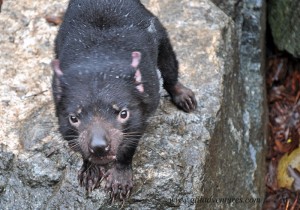 A tassie devil in the Taronga Zoo. We headed to Australia mostly to see these little guys. After some sorting through ideas, she settled on seeing Tasmanian devils and platypus. The tassie devils are on a path to extinction in the wild due to a highly contagious cancer. Captive breeding programs are being set up in places all over Australia and Tasmania to preserve the species. It seems this facial cancer does not live in the environment, so after the wild population has become extinct, the hope is that the animals bred in captivity can be released to establish a new population.
Although they forecast that they will be able to preserve 95% genetic diversity in the gene pool, there is a huge risk to the species. The platypus made her list not by being endangered, but for being just plain odd. So, Australia was added to our short list. Sydney had both species in their zoo, and there were wildlife parks not far which were also a part of the breeding program for the tassie devils. Chances of seeing a platypus in the wild are about the same as finding our daughter Marlie cleaning the kitchen without being asked or me swimming in ice water. To be sure of finding one, a zoo was the answer: Sydney, then.
Turns out, we all loved Sydney. Just as water sustains life, it gives vibrance to the city. Parks and promenades line the water’s edge. Sailboats bob quietly in each small bay. Ferries create a scenic public transportation system as they carry passengers from pier to pier. The water itself sparkles with the reflection of the sun by day and the famous opera house and city lights by night. Sydney Harbour creates open space, an expanse of unobstructed viewpoints.
We took the tourist trail, visiting the Australia Wildlife Park, and the Aquarium. I’d have to say, our wannabe marine biologist Marlie has dragged me to aquariums all over the world, and this might have been my favorite. The only downside was determinedly staring into the platypus enclosure for over a half an hour with no success of spotting one. We’d come a long way to peer into an empty tank.
The Sydney tower was a must, if only to compare with our previous visits to towers in Tokyo and Paris. Because Sydney has the largest IMAX screen in the world and John and I share a hero in Ernest Shackleton, we took the girls to see the oversized documentary about his Antarctic Adventures on the giant screen. John chose the Sydney Maritime Museum and we all enjoyed it far more than we’d expected, with its depictions of life at sea and Australia’s relationship with the water.
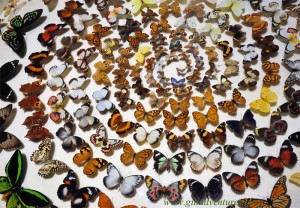 Butterfly display at the Australia Museum A favorite was the Australia Museum. Well, other than the giant crowd of completely out of control school children screaming and pounding on the exhibits. The museum has a remarkable section for aboriginal people and history, and we especially appreciated the exhibit about the stolen generation. About 100,000 aboriginal children were stolen from their families over the course of sixty years, to be raised in orphanages or white foster homes. Most were told their families had died. Another frightening example of racism and eugenics; it always shocks me what atrocities humanity is capable of. Surprisingly, this practice by the Australian government did not end until 1971.
We found our animals at the Taranga Zoo. We were almost the only people who stood in the drizzle for the zookeeper’s talk about Tassie Devils. Because the group was so small, we were able to have answered all of our question about the devil facial tumor disease and the animal’s habits. We also walked in the platypus house to find the little guy happily swimming about. We giggled and watched and fell in love with yet another amazing critter.
We did not make it out to the wildlife parks we had researched in the Central Coast. It would have meant a night away, and we were so enchanted by Sydney we opted not to leave town.
By Eva, on June 18th, 2011
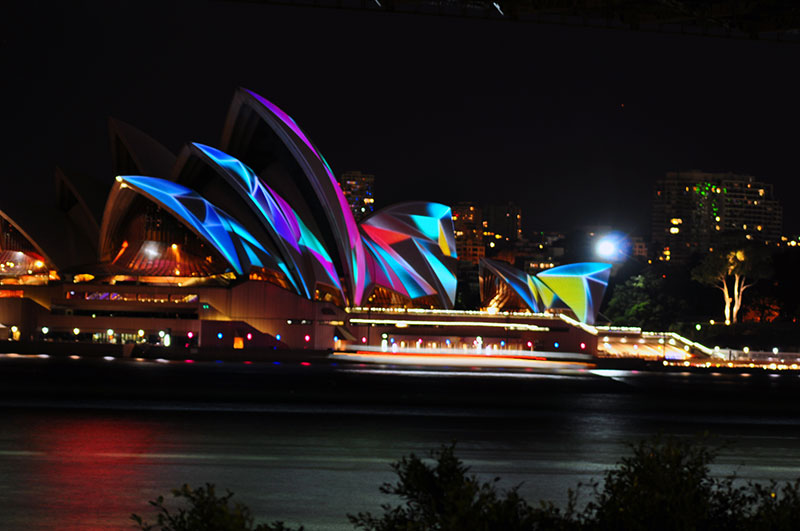 Our stay in Sydney happened to be during the Vivid Sydney festival of light. We watched the lighting of the sails of the opera house from our apartment. The long exposure created streaks as the ferry passed by. 
By Eva, on June 11th, 2011
 Ninjutsu demonstration in Japan at the Iga-ryu Ninja Museum
The Kansai region of Japan is well known for its historical significance. Visitors flock to famous sites such as Himeji and Osaka Castles. It boasts many superlatives: Hōryū-ji Golden Hall, the oldest wooden structure in the world, Tōdai-ji Main Hall, the largest wooden structure in the world, which houses Daibutsu, the largest bronze statue in the world, Japan’s tallest temple pagoda in Tō-ji, Kyoto. Even the animals make it onto the mainstream tourist track, with opportunities to feed bowing deer in Nara and mischievous macaques in Kyoto. Having spent time here before and had our fill of history over the past year, we sought out the quirky, quintessentially Japanese things in Osaka. 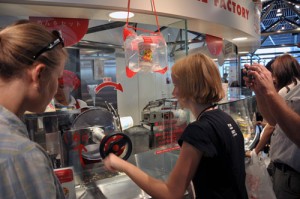
The Museum of Housing and Living has a wonderful walk-through re-creation of the city in earlier years, and smaller dioramas for periods from its beginnings to present. We were offered kimonos to wear completing the immersion into the past.
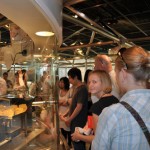 There is a museum dedicated to the invention of instant ramen. Centered around the quest of Momofuko Ando and his quest to create a nutritious food that would be easily stored and distributed in post world war two Japan. We watched a movie in Japanese about the history and people making noodles, we colored our own Cup a Noodle containers and had them filled with our choice of ingredients and flavors. There is a museum dedicated to the invention of instant ramen. Centered around the quest of Momofuko Ando and his quest to create a nutritious food that would be easily stored and distributed in post world war two Japan. We watched a movie in Japanese about the history and people making noodles, we colored our own Cup a Noodle containers and had them filled with our choice of ingredients and flavors.
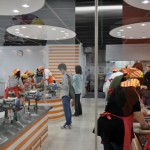 We didn't make the noodles ourselves, there was a large group of special needs kids at the museum the day we visited. Visitors can make reservations to go into the demonstration kitchen and learn more about how the noodles are made. We just watched the movie; it was in Japanese, but the animations made it pretty easy to follow. We tried our hand at throwing ninja stars in Iga City, the birthplace of Iga-Ryu Ninjutsu. The visit included a tour of a ninja house, complete with trap doors, and displays of clothes and weapons and history. The most impressive was the demonstrations by the masters of the art of ninjutsu, the ninjas.
Although none of these will make it onto the main tourist trail, they embody a part of Japan we love. Under all the aesthetics and beauty and pride, Japan is filled with quirkiness.  The timeline tunnel of the development of flavors and packaging of instant ramen.
By Eva, on June 10th, 2011
Our love for Japan began when we chose it years ago as a first overseas destination for our young children. Although our trip around the world with our now tween and teen girls was to be about exploring new places, all four of us found Japan creeping into our “I want to go there” lists. The quiet restraint of Japan’s gardens and temples and people, and their love for quirky experiences created an irresistible draw.
We watched news of the earthquake and tsunami that devastated Honshu’s Eastern coast and followed the precarious balance of nuclear containment with broken hearts. It will be a long road to recovery for that part of the country. Some places will be scarred forever.
Once the shock of the news wore off and the crisis lessened, the thought that Japan may be off our list crept into our minds. What would this mean for us? Should we still visit? Although Japan is a nation of islands, it is quite large; its land mass is about the size of Montana, almost 14 times the area of Massachusetts. The drive from Tokyo to Kyoto took a full day on our first visit; destinations away from the disaster struck area would surely be safe. Would it feel appropriate to visit while the country was still recovering from the shock? Were they ready for tourism? Most of our family and friends assumed we would drop it from our plans.
In our previous life, when we ran the dude ranch, we dreaded the summer fire season. Not just because of the all too real danger that our place could become nothing more than cinders, but because of the impact it had on tourism as a whole. If a large fire hit anywhere in Oregon, whether it was close to us or not, our phone would stop ringing. It’s all about perception. News of a forest fire out of control sent the message to those outside the western US that “Oregon is burning, don’t go there.” A fire several hours drive from us would turn away potential guests. It seems that right now the world’s perception is that Japan is not open.
We spent a week in the Osaka area, visiting castles, friends, and museums for the invention of instant ramen and the training of ninjas. We did not see many foreign tourists, but the restaurants and hotels and attractions are all still offering the tastes and experiences that made us love Japan. Besides, the death of tourism would be another blow to an already shaken economy. We chose to show our affection by not staying away.
By Eva, on May 31st, 2011

Our stay was full of crazy changes and false starts in Hong Kong. Sometimes, unexpected turns lead to magic. This week filled with roadblocks. Don’t get me wrong, we enjoyed Hong Kong and will probably go back some time to explore it more. But, little we did turned out as planned.
We began our week with illness. Marlie was hit the hardest, and spent the better part of her stay battling a fever. She’d take an upturn, and come out to explore with us, only to wilt a couple of hours later and head back to the couch. As days were filled with heads on pillows, other adventures were dropped from the list, especially those farther from the center of town. Macau was the first to be cut.
Little says “Hong Kong” to me like an evening at the horse races. I’ve imagined the track at Happy Valley, with horses and jockeys and trainers, and owners and socialites in boxes watching. Average people like us drinking beers and betting on horses, guessing randomly who might win. Our guide book told us races happened every Wednesday, Friday, and Saturday. Having all felt under the weather on Wednesday, our night at the races was postponed. On Saturday, our last chance, Hannah and I jumped on the Happy Valley tram while John stayed back with a fevered Marlie. We arrived at a closed down public entrance. Although lights were on, whatever was happening inside was not a horserace. Racing was not to be.
John’s wish for most places we travel involves local foods. What else in Hong Kong, but dim sum. Whenever we venture to Portland, the largest city in Oregon, we try to stop in at Fong Chong for dim sum. Dumplings and buns and chicken feet are rolled by our table on loaded carts, we try to find the pork and pea meatballs and shrimp dumplings, and steer clear of the tripe as the food wheels past us.
Our semi-trustworthy guide books sent us to Lin Heung Bakery, a famous dim sum Mecca in Hong Kong. Our first visit was at dinnertime, we’d missed the mid-day-only dim sum. We arrived earlier the next day, in time for the carts bearing foods. The restaurant was full, with what must have been more than 100 people. Over the next 45 minutes, three trolleys appeared, to be swarmed by people rushing to them as they emerged from the kitchen. Each cart held one type of dim sum, and we managed to get two buns filled with bean paste, four meatballs, and two unrecognizable bits of meat and fat wrapped in some sort of intestine. We left, unsatisfied. We never did find our Fong Chong of Hong Kong.
As Marlie was feeling a little better but not yet up for a big outing, we left her in the apartment to rest and headed to the “Big Buddha.” After reaching the end of a very long metro train ride, we arrived to find the famous 360 Skytram was closed for maintenance. It’s a gondola that takes about 25 minutes to reach the Po Lin Monastery from the metro station. We were redirected to the bus, instead, which takes a far less direct route over a mountain pass, about 45 minutes under normal circumstances. As we reached the bottom of the hill on the far side of the pass, our bus pulled over in a cloud of smoke. The smell of burning brakes filled the interior and our sinuses through the open door. Eventually, another arrived and took us the rest of the way. The Big Buddha became a several hour ordeal instead of a morning outing.
Our stay culminated with a frantic departure, aligned with the obstacles that had become normal over the past week. During our stay, John and I hiked through dense forest searching for the trail that had famous views on the peak, never finding it. When we returned to the peak with the girls, the smog was thick enough to almost completely shroud the skyline of Kowloon. We never figured out the bus system, as there are schedules but no route maps, either online or at the stops. We’d also cut short watching the laser light show from Kowloon when Marlie texted us to come home right away, as her ear began to ache.
I usually check our travel information the day before we depart; we were staying a week in Hong Kong, right? No. Monday, the day before our departure, our last day in Hong Kong, Hannah and I were talking about Disneyland. Marlie’s fever was still coming and going, and now she might have an ear infection. We debated on finding a doctor, but she still was just “somewhat” sick. Sick enough not to go to Disneyland, not so sick Hannah should skip it.
About the time we had decided all this, the doorbell rang. Our landlord had arrived with cleaning supplies and linen, and asked what time we’d be leaving. Our departure was on Monday. Not Tuesday. We’d missed our morning flight. After a panicked trip to the airline desk, the help of our landlord who drove me there right away, and a gracious airline who accommodated my stressed demeanor and babble about a child with a fever with re-booked tickets, we threw everything into our bags and scrambled to catch the next flight to Osaka. A departure as unpropitious as our stay.
By Eva, on May 28th, 2011
 Bird nests for sale in Hong Kong. Made fro the saliva of swallows, they are a key ingredient in bird nest soup.  This lovely package in a bird nest shop window is of perfectly arranged mealworms. They cook them into all sorts of things.  Dried starfish at a dried fish market. Our apartment is in the dried fish market area, so the lobby does not smell wonderful as we step out of the elevator.  Antelope horn. This window also displayed deer antlers in velvet, along with the top part of the deer head. The antlers are said to be good for the liver and heart. 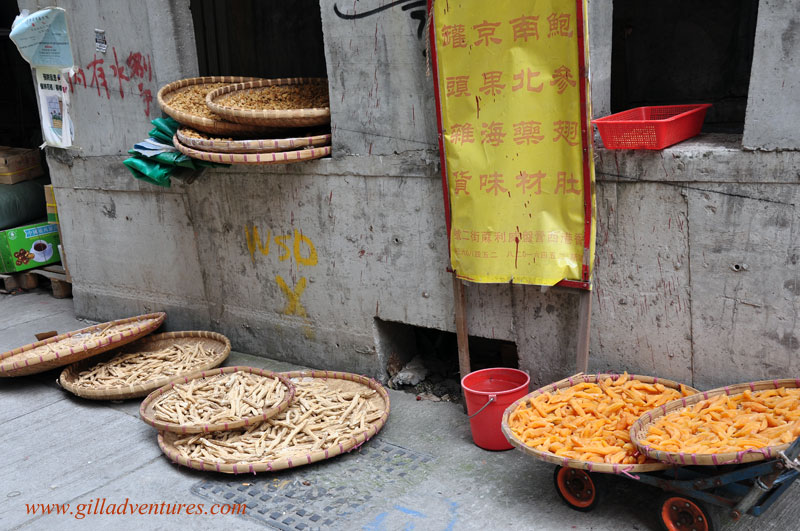 Fruit drying on the street side. This area, with dried fruits and flowers smelled much nicer than the dried fish streets.  Dried Fish. Nuff said.  Dried syngnathus pipefish.  Dried fish display, including smoked muscles and dried squid.  Several types of dried shrimp... where's Bubba?  Dried flowers  Dried sea cucumbers.  My personal favorite. Chicken gizzards (I think) drying on a traffic barricade.
By Eva, on May 27th, 2011
We had to cut things from our list. If there is one thing our travels have taught us, it might well be flexibility. Reality is rarely a straight fulfillment of the vision we have ahead of time. So much so, that we usually don’t schedule everything, but allow time for a place to unfold to us as we explore randomly. We’ve found far more magic there than in our planned moments. But, our current paring of our list is from headache and fever, not a search for serendipity.
Living at home, one’s one room is the favored place to recover from a bit of the “crud.” On the road it’s any comfy corner. Unfortunately, our Hong Kong apartment is one of the smallest we’ve had so far; not the best for catching up. I am sitting on the wood floor with my laptop atop my lap, as Marlie sleeps on the couch. (There is no bed for her, and no kitchen table.)
Although we are all typically pretty healthy, getting sick on the road does happen. GI travel ailments from changes in water and food. Hands grabbing rails in public transport and then itching an eye. Crowded airplanes with recirculated air and a woman across the aisle coughing. It is inevitable, but because our trip is no longer open ended, we can’t just tack on a few more days here to make up for those we lost.
When our renters gave notice they would be moving out, we tightened up our schedule to return home a couple months sooner than we’d imagined. We made a list of those places we still most wanted to see, and lined them up in our path. Tickets are purchased, short term apartments are rented. We also scheduled less time in each place. Less for exploration and school and work or maybe more importantly: down time. Our pace feels more rushed. When we get sick, we have to cut out more. Today, I’m letting everyone sleep in. The extra rest will do us good.
By Eva, on May 25th, 2011

We swam in our clothes in Vietnam. While we were staying in Hue, we made an afternoon trip to swim in the South China Sea. We’ve been collecting them: bodies of water we’ve been in. Sort of in the way tourists sometimes sightsee to check things off a list. Only wetter.
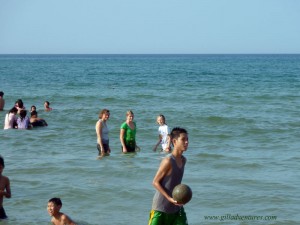 Headed into the water in our clothes out of respect for local modesty and sensibilities. We asked the cab driver (via an English speaking concierge in the Vina Hotel where we stayed) to take us to Thuan An, the nearest beach; a popular spot for local families filled with beach club/ restaurants. Naturally, we pulled into one where the cab driver liked to wait and drink tea with his cabbie friends. Not to worry, I don’t imagine there was a huge variation between the row of restaurants offering shaded bamboo platforms with grass mats available for rent by the hour. Being a summer Sunday, the waves were full of people. None but us were non-Asian, likely most were local.
Not one female over 12 years old was wearing a bathing suit that showed hips or cleavage. Almost every woman and girl was actually covered with t-shirts and shorts, even if we could tell they had swimsuits on underneath. The few swimsuits we saw looked like those we’ve seen in movies about the 40s and 50s. Certainly nothing like beaches on the Mediterranean or Adriatic, where topless is a norm and we’d happened across the occasional nude. (Not a local custom we embraced, ourselves, nor were they typically bodies anyone would prefer to see in that state…)
We knew that the more rural areas of Vietnam are more modest than in the cities, and Vietnamese women may wear sheer clothing, but will not reveal much bare skin. Now we know that is true even in the water. So, the girls and I sat and debated. We opted to follow the local custom and took to the water without taking off our shorts and tank tops, even if it meant an afternoon in wet denim that would stick to us the rest of the day.
By Eva, on May 21st, 2011
 A morning visit to the Market in Hue; this is a typical market in Vietnam. We liked the one in Hue more than those in Ho Chi Minh City because so many of the women were in traditional clothing and hats.  A food stall selling herbs, eggs, and chicken.  A woman selling fish. A bit different than the seafood case at Safeway... 
By Eva, on May 19th, 2011

Our first day in Hue, we decided to walk from our hotel to the citadel, the old emperor’s castle. After crossing the moat bridge and entering the old walled city, the cyclo-cabs descended like crows surrounding carrion. Several followed us up the street, repeating the “one hour tour,” “very cheap” sales pitch as they pedaled along next to us. Even though we think of ourselves as semi-feral and we’ve spent the last year and some months wandering around the globe, I suppose we do look like an average American family of tourists on vacation: tout and hawker bait. In most cases, a half dozen or so “noes” and they move on. Not our cyclo cab thugs.
Vietnamese bike taxis are different from ours at home. While our pedi-cabs have a seat off the back, on Viet cyclo cabs the customer sits in the front, where the handlebars are attached to a sort of wheelchair that replaces the front wheel, and are the modern equivalent of a rickshaw. The driver is referred to as a “cyclo.”
I’ve read the Vietnamese don’t really like to walk. Their sidewalks reflect this, although they are generally much easier to navigate than Thailand’s, they’re still full of holes and motorbikes. Nobody will choose to walk if they don’t have to, and they don’t really understand why we would walk when other options are available.
Maybe it was because we did not head directly toward the Forbidden Purple City after crossing the moat, but rather turned right into the old sector streets. A little lost, as we often are: our preferred state. Several cyclo cabs began trailing us. Not a direct attack, just following, looking for weakness. A crowd gradually dropping off to just one. The rest left as we went to a little market to buy ice cream for Marlie. This final cyclo followed us as we walked for half an hour, attempting to interrupt our conversation every few minutes to remind us that he would take us through the old city for an hour, very cheap. Every so often, he would point off down a street (often away from the Imperial City) suggesting that was where we should go, we supposed he was thinking the walking and the heat would soon tire us out and we’d want that “one hour tour.”
We dropped into a coffee shop for some water and iced coffee, partly because we were thirsty, and partly to ditch him. He waited outside, and even had a second driver stop and wait with him. We felt a bit like prey, the predator waiting for us to come out of our hole or tree. As we emerged another 45 minutes later, we offered him yet another “no, thank you,” and wandered toward the Imperial City, and he finally gave up and pedaled off. He’d spent more time following us than the tour he was offering.
We did want to try a cyclo cab sometime, and hours later as we turned to head home, our tired feet told us it would be a good time to do so. We found, talking to a cyclo tout (read:cyclo-pimp,) that a cyclo cab was much more expensive than what we would expect to pay a tuk tuk or taxi. We agreed on a price about 40% less than what they first asked for, but still more than other options. We figured it would be worth the experience.
We squeezed in double, two per cyclo cab, the person in back perching on a little plank set across the arm rests. John’s broke during the ride, and wound our way slowly through traffic and over the bridge to our hotel. At the end of the ride, the cylcos angrily insisted we owed them more than the price we agreed on: “far, so very far.” We’d shown the tout (cyclo-pimp) the address, they knew how far it was. Certainly not a “one hour tour.”
By Eva, on May 17th, 2011
“Just go slow, be predictable.” As we waded into the stream of scooters and motor bikes that fill the streets of Ho Chi Minh City, I reminded the girls of this mantra. Magically, the oncoming river of bikes managed not to wipe any of us out, although they did come within inches of us on either side. A “break in traffic” does not exist, walking through it is the only path to the other side. We’d thought there were a lot of motorized bikes in Thailand, but it does not come close to the numbers in Saigon. Crossing the street is an adventure!
There are other things about the traffic that are curious to us here. At home, typically, the larger entity yields to the smaller one. Trucks watch for cars and move slowly through congested areas. Car watch for bikes, and everyone watches out for pedestrians. (At least in theory.) Here, the smaller most always yields to the larger. As a pedestrian, you can walk into the stream of motorbikes, so long as they can predict where you will be; no lunging or stopping. But, if a car or truck is coming, wait for it to pass, as it will not stop for you.
They will honk to let you know they are coming. Unlike honking back home, which is seen as aggressive, here it is intended for your safety and for the safety of those around you. I’ve come to appreciate a honk from the motorbike coming up the sidewalk behind me, because then I know it is there. Better than the one that I don’t hear and nearly get knocked over by as it runs over my feet.
So, as our family crosses, we try to make ourselves as small a target as possible by walking side by side, and just go. We never thought traffic could be a thrill.
By Eva, on May 16th, 2011
 The Vietnamese carry everything on their scooters and motorbikes. We found watching the traffic in Ho Chi Minh City entertaining.  At the Tan Binh Market 
 Another heavy load at the Tan Binh Market. We saw people carry sheet metal, poles, several cases of cola, and all sorts of baskets of food on their small motor bikes.  Jackfruit are huge and must be cut apart to eat, typically small portions are made available by women on the streets. Most Americans only know jackfruit as the flavor of Juicy Fruit gum, although the fresh fruit is much better. One of our favorite snacks! 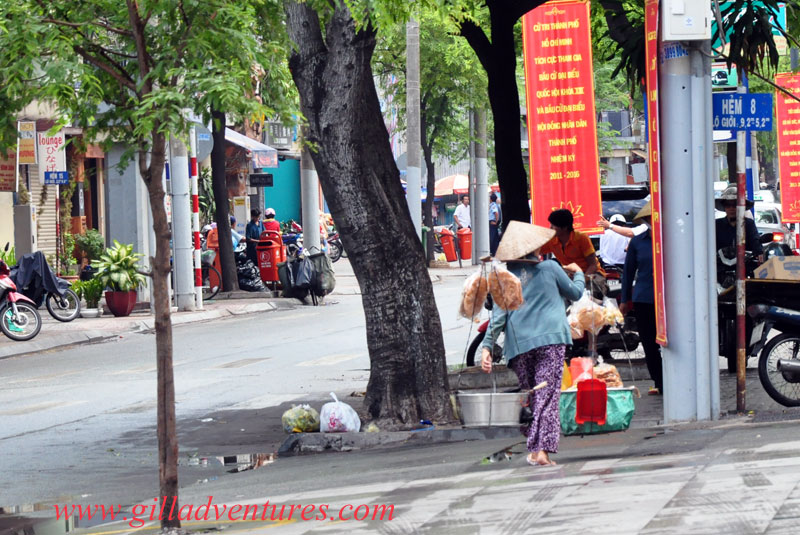 Women set up little cafes on the street with what they can carry.  Street food. Here, rather than from carts, food vendors often set up with minimal equipment that they carry by hand or on a motorbike.   Mobs of motorbikes. This was a small crowd...  Parking lot on the sidewalk
|
Networked Blogs on Facebook
|

 .
. .
. .
. .
.















































